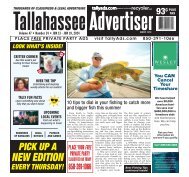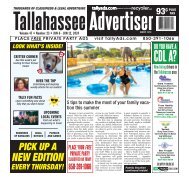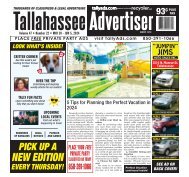TLA37_AllPages
Create successful ePaper yourself
Turn your PDF publications into a flip-book with our unique Google optimized e-Paper software.
CAPITOL RECAP<br />
The FMCSA’s May 14 notice requests comments on a second pilot<br />
program to allow nonmilitary drivers ages 18-20 to operate CMVs in<br />
interstate commerce.<br />
When it requested comments on the pilot involving military drivers,<br />
the FMCSA received 67 comments to the docket, 18 of which asked<br />
the agency to expand the current pilot program or initiate a new one<br />
specifically for younger drivers to operate in the agricultural sector.<br />
The request for comments comes just over two months after<br />
companion bills were introduced in the House of Representatives and<br />
the Senate called the “Developing Responsible Individuals for a Vibrant<br />
Economy Act” (DRIVE-Safe Act), which proposes to lower the age<br />
requirement for interstate drivers to 18 as long as the younger drivers<br />
participate in an apprenticeship program that includes separate 120-<br />
hour and 280-hour probationary periods, during which younger drivers<br />
would operate CMVs under the supervision of an experienced driver<br />
and must achieve specific performance benchmarks before advancing.<br />
Younger drivers would also drive vehicles equipped with active braking<br />
collision mitigation systems, forward-facing video event capture and<br />
speed limiters set to 65 miles per hour.<br />
Similar legislation was introduced in the last Congress, but never<br />
made it out of committee.<br />
FMCSA requests comments on the training, qualifications,<br />
driving limitations, and vehicle safety systems that FMCSA should<br />
consider in developing options or approaches for the possible<br />
second pilot program for younger drivers.<br />
The request from comments on the all-encompassing pilot program<br />
suggests the need for answers to several questions:<br />
• What data are currently available on the safety performance of 18-<br />
to 20-year-old drivers operating CMVs in intrastate commerce?<br />
• Are there concerns about obtaining insurance coverage for drivers<br />
under 21 who operate CMVs in intrastate commerce, and would these<br />
challenges be greater for interstate operations?<br />
• What is the minimum driving experience that should be required for<br />
a driver to be admitted to a pilot?<br />
• Should there be a requirement for experience driving noncommercial<br />
vehicles (e.g., to hold a regular driver’s license for some minimum<br />
period of time)?<br />
• Should there be a requirement for experience driving a CMV in<br />
intrastate commerce for some minimum amount of time? If so, what<br />
should that amount be and how should it be measured (e.g., time with a<br />
CDL, hours driven, vehicle miles traveled) and why?<br />
• Is there a minimum amount of time a younger driver should be<br />
required to hold a CLP or CDL? If so, how long and why? Are there<br />
driver training topics that should be required for younger drivers beyond<br />
those covered in the ELDT final rule? If so, what are they and why?<br />
• Should younger drivers have more limited hours of service, such as<br />
a maximum of eight hours of driving each day? If so, what limits should<br />
be applied and why?<br />
BREAKING DOWN AUTOMATED BARRIERS<br />
The National Highway Traffic Safety Administration and<br />
FMCSA have issued advance notices of proposed rulemaking on the<br />
removal of unnecessary regulatory barriers to the safe introduction<br />
of automated driving system (ADS) vehicles in the United States.<br />
NHTSA and FMCSA are seeking comments at this stage to<br />
ensure that all potential approaches are fully considered as the<br />
agencies move forward with these regulatory actions.<br />
The ANPRM released by the Federal Motor Carrier Safety Administration seeks public<br />
comment on questions regarding several key regulatory areas to better understand how<br />
changes to its rules can account for significant differences between human operators and<br />
automated vehicles.<br />
“This is the coming technology, and if science backs it and the<br />
data supports it, obviously it becomes an avenue we have to go<br />
down,” said David Heller, TCA’s vice president of government<br />
affairs.<br />
But it’s important to remember that automated technology is not<br />
going to replace drivers, he quickly added.<br />
Heller believes automated technology is so far down the road<br />
that the request for comments is just the<br />
beginning for the questions that must<br />
be asked or answered, including where,<br />
what, when and how.<br />
“And in order to get those answers,<br />
automated technology has to be tested,”<br />
he added. “And right now, there are not<br />
very many areas when they can be tested,<br />
and that’s holding up this playing field a<br />
little bit.<br />
“Everyone wants to be part of the<br />
talk about automated technology,”<br />
Heller said. “Everyone wants to be in<br />
the front of new technology that can<br />
basically revolutionize the delivery of<br />
freight across this country, and that’s the<br />
endgame,” he said. “It’s getting to the<br />
endgame that really muddies the water,<br />
things such as safety, costs, insurance,<br />
liability and cybersecurity.<br />
“All these things come into play and<br />
have to be ironed out, and we’re not even<br />
close to getting any of those answers. So,<br />
10 TRUCKLOAD AUTHORITY | www.Truckload.org TCA 2019

















